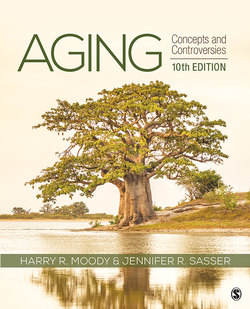Читать книгу Aging - Harry R. Moody - Страница 77
На сайте Литреса книга снята с продажи.
Cellular Theory
ОглавлениеA major finding from cell biology is that normal body cells have finite potential to replicate and maintain their functional capacity. This potential appears to be intrinsic and preprogrammed, part of the genetic code. The cellular theory of aging argues that aging ultimately results from this progressive weakening of capacity for cell division, perhaps through exhaustion of the genetic material. That cellular limit, in turn, may be related to the maximum life span of species.
One of the major milestones in the contemporary biology of aging was the discovery that cells in laboratory culture have a fixed life span. Leonard Hayflick (1965) found that normal human cells in tissue culture go through a finite number of cell divisions and then stop. This maximum number of divisions is known as the Hayflick limit. Hayflick found that cells replicate themselves around 100 times if they are taken from fetal tissue. But if taken from a 70-year-old, they reach their limit of “aging” after 20 or 30 divisions.
Cells taken from older organisms divide proportionately fewer times than those taken from younger ones. Normal human cells that are frozen at a specific point in their process of replication and later thawed seem to “remember” the level of replication at which they were frozen. Furthermore, normal cells from a donor animal that are transplanted will not survive indefinitely in the new host.
Cell division in the laboratory sheds light on an interesting question: Can human bodies become immortal? The answer is yes, but there’s a catch. We have to get cancer to do it. The classic instance is the case of so-called HeLa cells—an immortal remnant of a terminally ill young woman named Henrietta Lacks (HeLa), who died in Baltimore in 1951 (Skloot, 2010). Before she died, a few cancerous cells were removed from her body and put into tissue culture: essentially, put down on a glass lab dish and supplied with cell nutrients. Scientists were surprised to find that these HeLa cells just kept dividing and growing. In the years since, the cells haven’t stopped growing. So we might say that a little piece of Henrietta Lacks has achieved immortality in a laboratory dish.
By contrast, in normal cell differentiation, cells divide and become more specialized, and their ability to live indefinitely simultaneously declines. The Hayflick limit may be not so much an intrinsic limit on living cells as a limit on when cells begin to differentiate, as in development of the embryo. When cells approach a limiting point, a genetic program normally shuts down the capacity for further division. If the genetic program doesn’t work, the result is uncontrolled multiplication, or cancer. The Hayflick limit doesn’t keep all cells from dividing—after all, germ cells such as eggs and sperm continue to divide—but it may give a clue about why aging brings an increase in cancer and a weakening of the immune system.
Studying aging by examining cells in a test tube raises some questions. For instance, the nutrient medium in a cell culture does not contain all the nutrients and hormones that a cell would normally receive. In addition, cells in the body become differentiated tissues and organs and remain in equilibrium in ways quite different from the way cells replicate in a test tube.
Fundamentally, the cellular theory of aging sees aging as somehow programmed directly into the organism at the genetic level. In this view, it is just as natural for the body to grow old as it is for the embryo or the young organism to develop to maturity, as we see in annual plants or the Pacific salmon. Does the cellular program theory of aging therefore apply to higher organisms such as mammals and, specifically, human beings? Perhaps, but it does not apply as obviously as it does to organisms in which rapid aging is tied to reproduction.
One of the most intriguing points in favor of the cellular approach to aging is the discovery that tiny tips at the ends of chromosomes—structures known as telomeres—become shorter each time a cell divides. Telomeres, it seems, comprise a biological clock marking the unique age of a cell as it divides. Studies are under way to explore the link between aging at the cellular level and what we recognize as aging in complete organisms. Elizabeth Blackburn won the Nobel Prize in Medicine for discovering the role of telomeres, which evidently play a crucial role in cellular aging (Brady, 2009). Biologists now understand that the length of a telomere can serve as a biomarker, or measurement of biological age beyond chronological age alone. Studies are under way to see if specific interventions can slow down the process of biological aging.
